The Federal Hydrogen Hub Community Guide
The Federal Hydrogen Hub Program
A detailed overview of the Hydrogen Hub Program, including descriptions of each of the seven Hubs selected by DOE to negotiate for funding
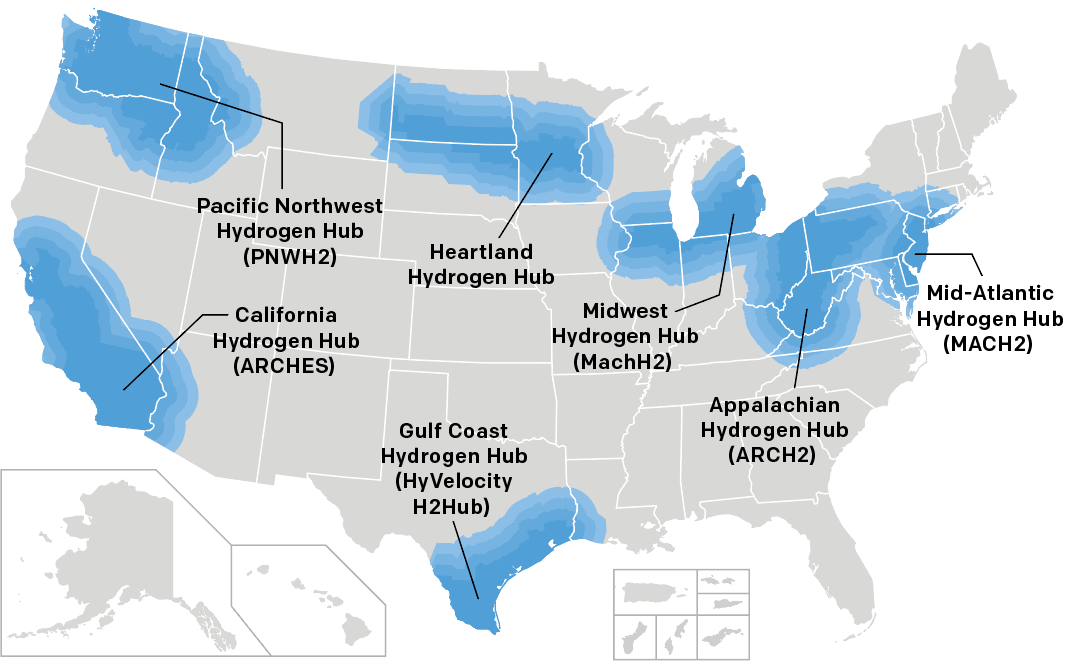
On Jan. 28, 2025, the Department of Energy published a memo instructing all funding recipients and subrecipients to “cease any activities” associated with Community Benefits Plans.
The memo indicates that additional guidance will follow, and we will update the Guide as we get information about how the Hub Program will be affected.
This resource is part of the Federal Hydrogen Hub Community Guide.
The federal government’s goal for the Hydrogen Hub Program is to create a hydrogen network that spans the country.
Each Hub will include hydrogen producers, hydrogen users, and infrastructure to transport hydrogen between the two.
The Dept. of Energy and the Hubs have shared limited information with the public so far.
- Each Hub has said it will create jobs and provide other local benefits, including other economic benefits like new funding for businesses and workforce training programs, and environmental benefits from pollution reductions.
- But publicly available details on the proposed Hubs include many projects that would increase both climate and community-level pollution, waste energy, and delay better climate solutions.
- Accurately assessing potential benefits and harms will not be possible until significantly more detail on Hub projects is made available.
DOE will award funding across four phases over the next 8-12 years. At the end of each phase, DOE will decide whether to continue or stop funding each Hub and specific projects within them.
Phase 1:
Detailed Plan
1¼ years*
Phase 2:
Project Development
2½ years*
Phase 3:
Implement & Construct
3½ years*
Phase 4:
Ramp-Up & Operate
3 years*
* Approximate time to complete phase
This detailed graphic from DOE shows the activities that are supposed to take place during each of the four phases. Each phase provides opportunities for communities and advocates to push for just outcomes, and DOE says it will consider community input when making its funding decisions:
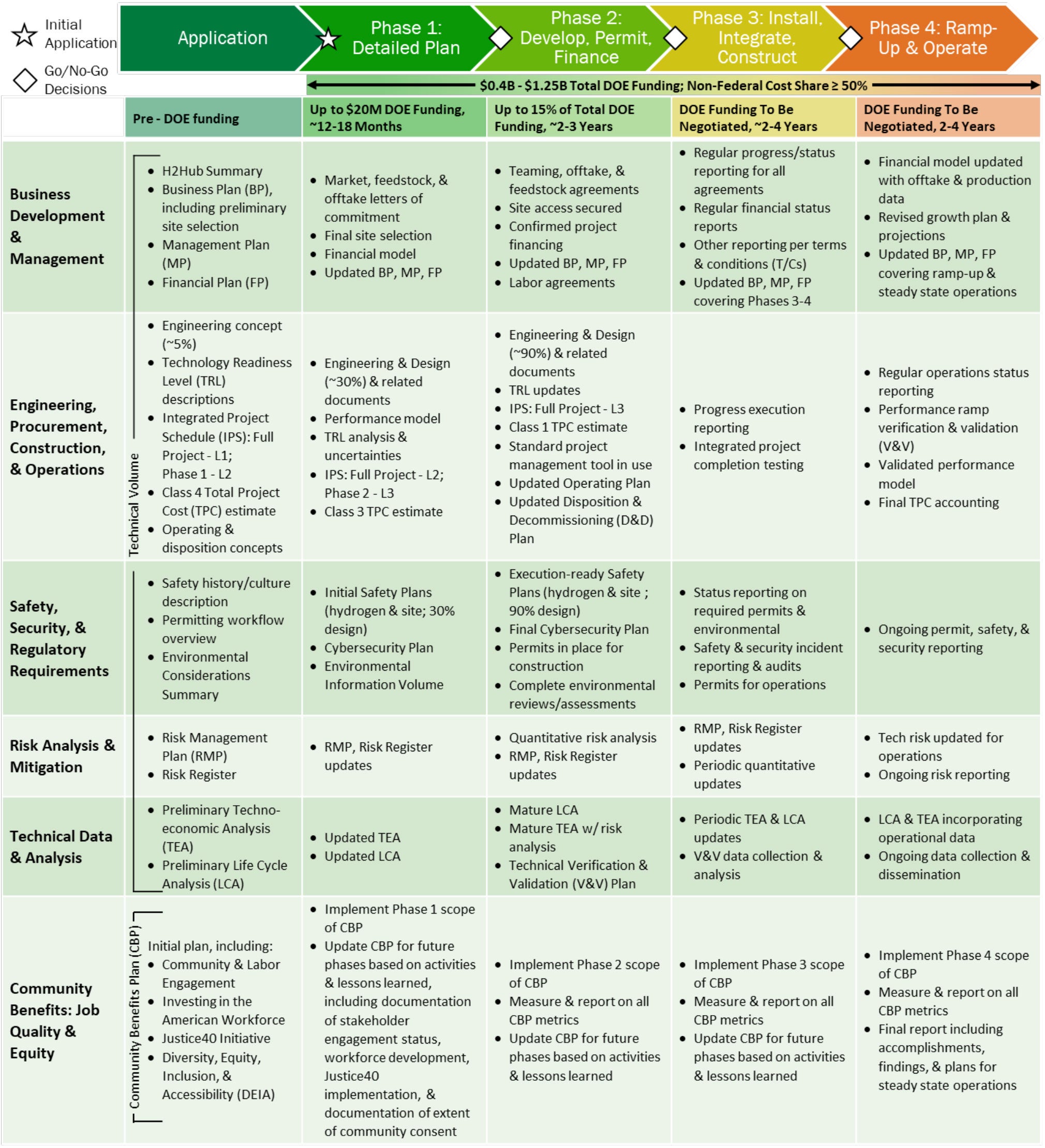
Summary of activities and outcomes in each of the four phases. View full-size graphic. (Dept. of Energy)
Phase 1 begins after each Hub completes its initial negotiations with DOE. According to DOE, communities can expect Hubs to take the following actions (among others) during Phase 1:
- Release more information on Hub plans and projects to the public;
- Engage directly with impacted communities;
- Release summaries of community commitments (DOE described this summary for a different DOE program as an example of how the summaries might look).
DOE has also said that Hub projects will not seek permits or begin construction during Phase 1, and that failure to meet DOE goals for Phase 1 (including robust community engagement) will affect whether DOE continues to fund a Hub in future phases.
The Seven Proposed Hydrogen Hubs
As of January 2025, each of the seven Hydrogen Hubs has received the first installment of federal Hydrogen Hub Program funding for planning, development, and community engagement activities. Details about the Hubs are still limited and largely based on DOE’s September 2022 Funding Opportunity Announcement for the Hydrogen Hub Program and October 2023 briefing on the Hubs, as well as specific DOE briefings and fact sheets on each of the Hubs, linked below. This section highlights key details, including what Hub claims about the benefits of their projects. Hubs could end up providing more, less, or different benefits.
For questions or concerns about the Hubs, we encourage you to contact Suzanne Baker, DOE’s Stakeholder Engagement Lead for the Hydrogen Hub Program, at suzanne.baker@hq.doe.gov, in addition to the Hub-specific contacts provided below.
Appalachian Hydrogen Hub (ARCH2)
In West Virginia, Ohio, and Pennsylvania
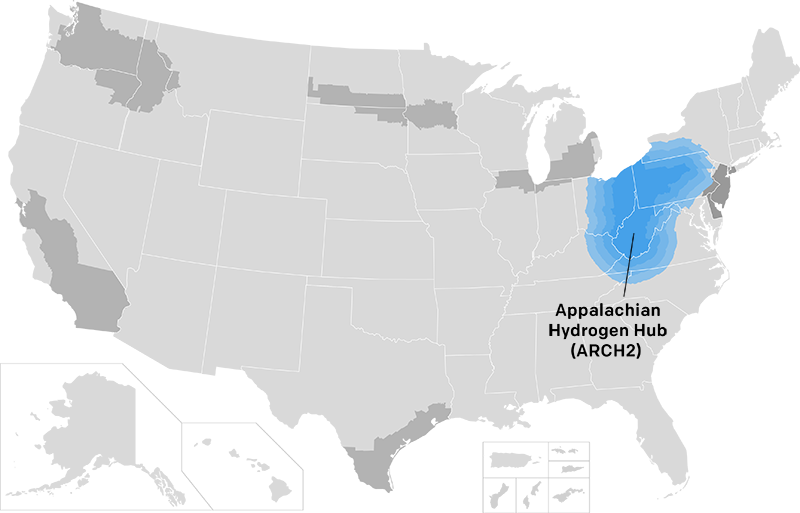
Funding: Up to $925 million
Status: In July 2024, DOE awarded ARCH2 with $30M for Phase 1 activities, which are expected to last up to 36 months and include planning, design, and community and labor engagement.
- Fossil fuels in a process that includes carbon capture‡ technology and CO2 storage‡ for seven of ten production facilities.
- Also some production from water and biomass/food waste. Biomass‡ refers to wood, crops, animal waste, and other material from plants and animals that can be burned to create energy.
- Fuel for trucks and public transit
- Ammonia‡ production
- Electricity generation
- Residential uses
- Industrial uses
- New hydrogen pipelines and fueling stations
- Permanent CO2 storage‡
- Jobs
- Creation of Community Benefits Advisory Board and Community Benefits Steering Committee
- Local stakeholder input on specific projects
- A public data-reporting platform
Resources & Contact
- DOE ARCH2 Webpage, including Project Fact Sheet and Community Benefits Summary
- DOE ARCH2 Community Briefing
- DOE Contact: AppalachianH2Hub@hq.doe.gov
California Hydrogen Hub (ARCHES)
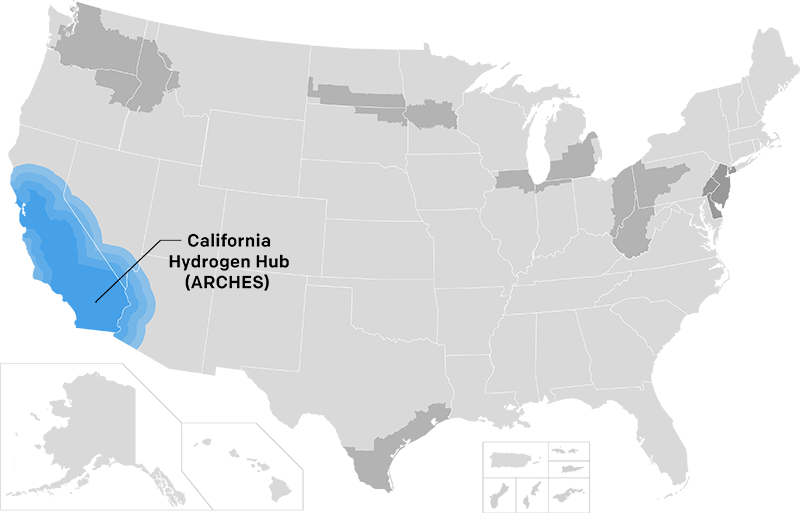
Funding: Up to $1.2 billion
Status: In July 2024, DOE awarded ARCHES with $30M for Phase 1 activities, which are expected to last up to 18 months and include planning, analysis, design, and stakeholder engagement.
- From water
- From biomass‡ / food waste in a process that includes carbon capture‡ technology and CO2 storage‡
- Fuel for trucks, port equipment, and public transit
- Electricity generation
- New heavy-duty hydrogen fueling stations
- 165 miles of pipeline
Community Benefits Plan: A copy of ARCHES’ Community Benefits Plan is available online.
- Jobs
- Creation of Community Benefits Working Group at the Hub-level to advise on impacts and benefits, independent Community Benefits Auditing Team to track and publicly report on benefits, and Local Community Working Groups for specific Hub projects
- Project Labor Agreements and Community Benefits Agreements/Plans
- A public data-reporting platform
Resources & Contact
- DOE ARCHES Webpage, including Project Fact Sheet and Community Benefits Summary
- DOE ARCHES Community Briefing
- DOE Contact: CaliforniaH2Hub@hq.doe.gov
Gulf Coast Hydrogen Hub (HyVelocity H2Hub)
In Texas
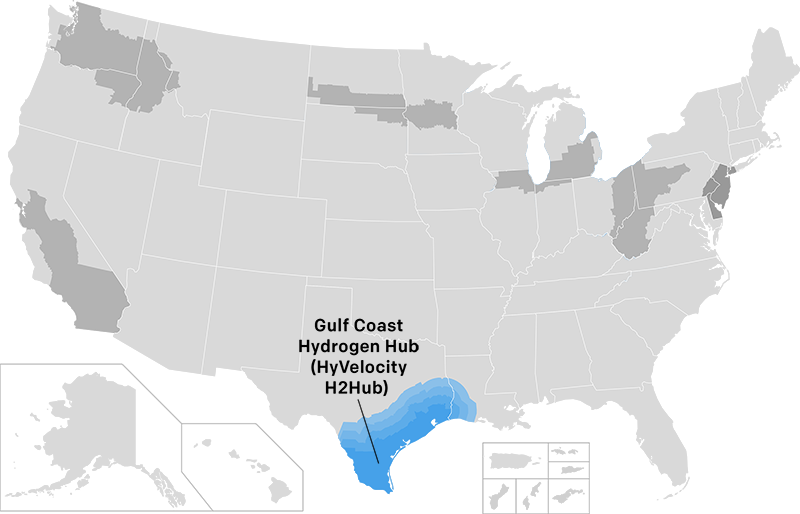
Funding: Up to $1.2 billion
Status: In November 2024, DOE awarded the HyVelocity Hub with $22M for Phase 1 activities, which are expected to last up to 18 months and include planning, development, and community and labor engagement.
- From water
- From fossil fuels in a process that includes carbon capture‡ technology and CO2 storage‡
- In oil refineries and petrochemical facilities (using hydrogen to produce fuels, chemicals, and plastic products)
- Fuel (including methanol) for trucks and marine vessels
- Ammonia‡ production
- Electricity generation
- New hydrogen pipelines and fueling stations
- Hydrogen and CO2 storage‡ in salt caverns
- Jobs
- Creation of Community Advisory Board
- Air pollution reductions
Resources & Contact
Heartland Hydrogen Hub
In Minnesota, North Dakota, and South Dakota
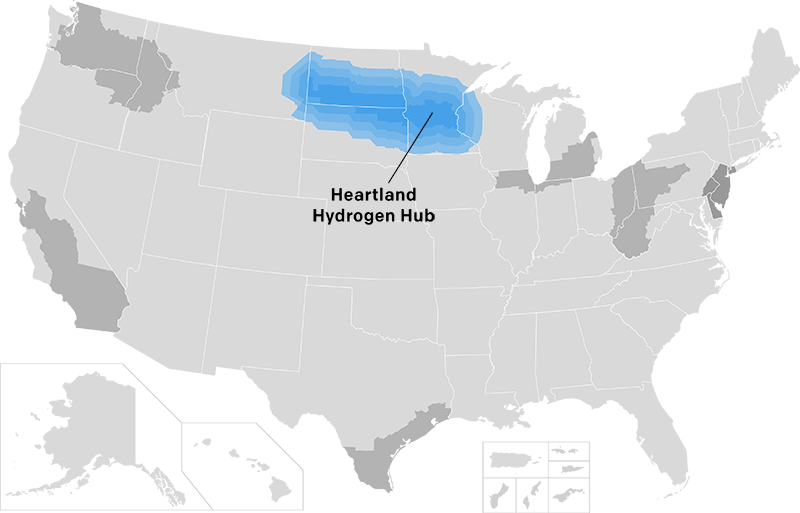
Funding: Up to $925 million
Status: In January 2025, DOE awarded the Heartland Hub with $20M for Phase 1 activities, which are expected to last up to 48 months and include planning, development, and community and labor engagement.
- From water
- From fossil fuels in a process that includes carbon capture‡ technology and CO2 storage‡
- Ammonia‡ production
- Electricity generation
- New hydrogen pipelines
- Jobs
- Creation of an education consortium to oversee education and training initiative
- Contracting opportunities for businesses owned by women, minorities, disabled veterans, disadvantaged communities, or LGBTQ persons
Resources & Contact
Mid-Atlantic Hydrogen Hub (MACH2)
In Pennsylvania, Delaware, and New Jersey
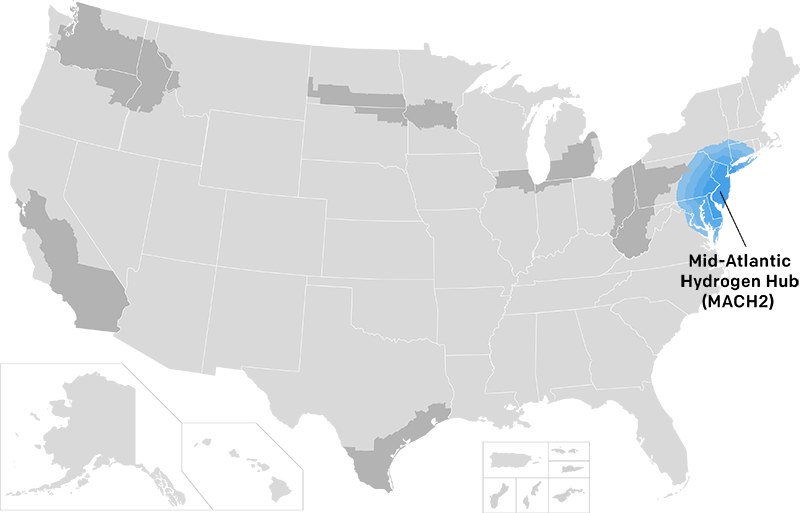
Funding: Up to $750 million
Status: In January 2025, DOE awarded MACH2 with $18.8M for Phase 1 activities, which are expected to last up to 15 months and include planning, preliminary design, and community and labor engagement.
- From water
- From fossil fuels in a process that includes carbon capture‡ technology and CO2 storage‡
- Truck fuel
- Electricity generation
- Expanded pipeline infrastructure
- New hydrogen refueling stations
- Jobs
- Project Labor Agreements for all Hub projects
- Investments in regional Workforce Development Boards and technical and professional development initiatives
Resources & Contact
- DOE MACH2 Webpage, including Project Fact Sheet and Community Benefits Summary
- DOE MACH2 Community Briefing
- DOE Contact: MidAtlanticH2Hub@hq.doe.gov
Midwest Hydrogen Hub (MachH2)
In Illinois, Indiana, and Michigan
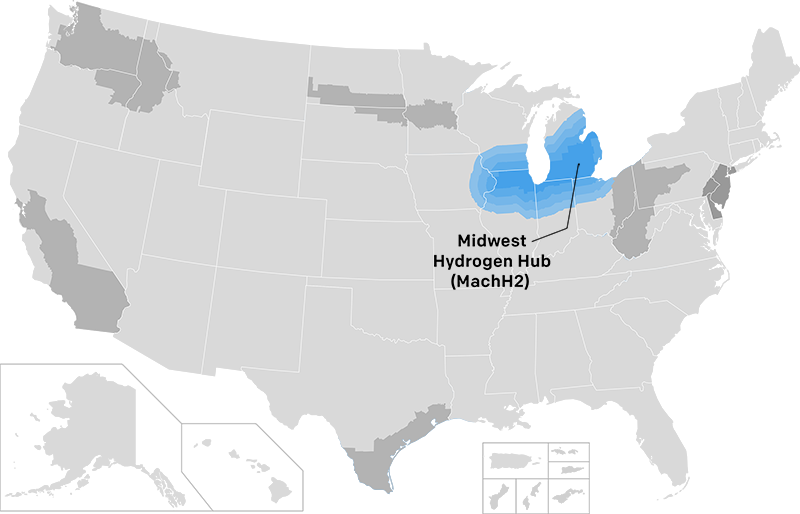
Funding: Up to $1 billion
Status: In November 2024, DOE awarded MachH2 with $22.2M for Phase 1 activities, which are expected to last up to 18 months and include planning, development, and community and labor engagement.
- From water
- From fossil fuels in a process that includes carbon capture‡ technology and CO2 storage‡
- Steel manufacturing and refining
- Truck fuel
- Electricity generation
- “Sustainable aviation fuel” production
- New hydrogen pipelines and hydrogen refueling stations
- Jobs
- Contracting targets for minority/disadvantaged businesses
- Investments in startups and worker education
Resources & Contact
- DOE MachH2 Webpage, including Project Fact Sheet and Community Benefits Summary
- DOE MachH2 Community Briefing
- DOE Contact: MidwestH2Hub@hq.doe.gov
Pacific Northwest Hydrogen Hub (PNWH2)
In Washington, Oregon, and Montana

Funding: Up to $1 billion
Status: In July 2024, DOE awarded PNWH2 with $27.5M for Phase 1 activities. Phase 1 is expected to last 12-18 months and include planning, analysis, design, and community and labor engagement.
- From water using 95% carbon-free energy and 100% carbon-free energy by 2035
- In oil refineries and data centers
- Fuel for trucks, port equipment, and public transit
- Electricity generation
- Long-duration energy storage
- Fueling stations and pipelines
- Hub-level Community Benefits Committee and “node-level” Community Advisory Boards
- Jobs
- Community Benefits Agreements/Good Neighbor Agreements
- Negotiation of Project Labor Agreements for all Hub projects over $1 million
- Community Workforce Agreements
- Investments in worker training
Resources & Contact
- DOE PNWH2 Webpage, including Project Fact Sheet and Community Benefits Summary
- DOE PNWH2 Community Briefing
- DOE Contact: PacificNWH2Hub@hq.doe.gov
Community Benefits Plans
Each Hydrogen Hub must create and comply with its own Community Benefits Plan. DOE has published Guidance on these Plans that includes strong expectations for how Hubs engage, impact, and stay accountable to communities. Among other criteria, Hubs’ Community Benefits Plans are supposed to:
- Demonstrate how Hubs will meaningfully engage communities early, often, and throughout the Hydrogen Hub Program.
- Identify concrete steps to provide benefits and minimize negative impacts to communities, particularly environmental justice communities.
- Detail how Hubs will measure, track, and report on their engagement, benefits, and negative impacts.
The degree to which Hubs will be held accountable to these criteria and expectations, and the specific ways in which DOE will enforce them, remain to be seen.
On Jan. 28, 2025, the Department of Energy published a memo instructing all funding recipients and subrecipients to “cease any activities” associated with Community Benefits Plans.
The memo indicates that additional guidance will follow, and we will update the Guide as we get information about how the Hub Program will be affected.
Common Types of Hydrogen Hub Projects
Hydrogen Production
- Industrial facilities that produce hydrogen from fossil fuels through a process called methane reformation.
- This process also produces CO2, and these facilities may include carbon capture‡ technology and CO2 storage‡.
- Facilities that produce hydrogen from water through a process called electrolysis‡ that is powered by electricity.
- To be clean, this process must be powered by renewable electricity that meets certain criteria.
- Facilities that produce hydrogen from biomass‡ through gasification‡ or methane reformation.
- These facilities may include carbon capture‡ technology and CO2 storage‡.
Hydrogen Use
For power or heat in:
- Power plants that burn hydrogen to generate electricity
- Projects that blend hydrogen into gas pipelines to heat buildings
- Projects that generate electricity from hydrogen fuel cells, which are like batteries
For high-heat industrial processes, like steel manufacturing
For chemical manufacturing in industrial facilities that produce:
→ In this Guide: Projects that Use HydrogenTransportation / Storage
Of hydrogen in:
- Pipelines between producers and users
- Vehicle fueling stations
- Storage sites
Of CO2 in:
- Pipelines that carry CO2 produced and captured at hydrogen industrial facilities to a storage site
- Storage sites (which are often geological storage sites where CO2 is injected underground)
‡Carbon capture refers to a set of industrial technologies designed to reduce CO2 emissions at the source (i.e., smokestack) of a facility and prevent on-site CO2 emissions from entering the atmosphere. See full definition.
‡CO2 storage, also known as sequestration, can refer to different things. When discussed in this guide, CO2 storage refers to storage in saline aquifers, which are deep underground and filled with salty water (brine).
‡Biomass can be processed and used in ways that lead to meaningful decarbonization, but also in ways that increase carbon emissions.
‡Exposure to ammonia can irritate the nose, throat, and respiratory tract, which can also lead to respiratory issues.
‡Electrolysis is used to split water into hydrogen and oxygen. See full definition.
‡Gasification is a process through which complex carbon-based materials are converted into syngas, a gas mixture composed of carbon oxides and hydrogen gas. See full definition.
Updated on January 28, 2025
Maps and graphics by Casey Chin / Earthjustice. Basemap data sources: Esri, HERE, Garmin, FAO, NOAA, USGS, EPA.
This guide is intended for informational purposes only and does not constitute legal advice. The information contained herein is not a substitute for professional legal counsel. Please consult with an attorney to discuss your specific legal needs.
Questions? For questions or feedback on this Guide, please contact us at webmaster@earthjustice.org
Earthjustice’s Clean Energy Program uses the power of the law and the strength of partnership to accelerate the transition to 100% clean energy.
